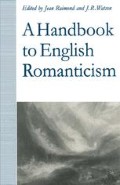Abstract
The origins of the interest in the marvellous in the Romantic period were similar to those which led to the Gothic novel. The principal one was the desire to subvert prevailing hierarchies of established values and systems of belief: to this end, Thomas Gray described the strange figure of the bard, standing on a mountaintop and defying the armies of the conquering Edward I. The bard was a figure from an earlier age (like the minstrel, whose departure was lamented by Blake and Scott), unusual, prophetic, isolated, strange. In the same way ghosts, magicians and witches all acted as figures who helped to challenge the accepted norms of social behaviour and intellectual belief. They acknowledged the irrational as opposed to the rational, and allowed into fiction and poetry (and occasionally drama) areas of feeling and action which were distinctly out of the ordinary.
Access this chapter
Tax calculation will be finalised at checkout
Purchases are for personal use only
Editor information
Editors and Affiliations
Copyright information
© 1992 Palgrave Macmillan, a division of Macmillan Publishers Limited
About this chapter
Cite this chapter
Watson, J.R. (1992). The Marvellous and Occult. In: Raimond, J., Watson, J.R. (eds) A Handbook to English Romanticism. Palgrave Macmillan, London. https://doi.org/10.1007/978-1-349-22288-9_47
Download citation
DOI: https://doi.org/10.1007/978-1-349-22288-9_47
Publisher Name: Palgrave Macmillan, London
Print ISBN: 978-1-349-22290-2
Online ISBN: 978-1-349-22288-9
eBook Packages: Palgrave Literature & Performing Arts CollectionLiterature, Cultural and Media Studies (R0)

